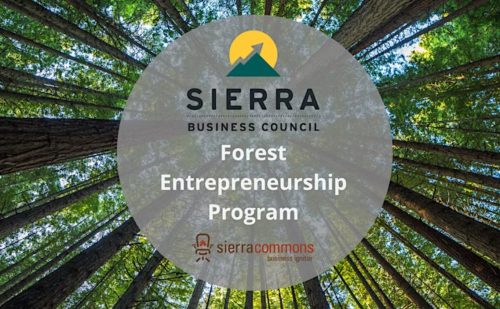The New Timber Economy
 The New Timber Economy: A Shift Toward Sustainability Creates New Career Opportunities in Rural California
The New Timber Economy: A Shift Toward Sustainability Creates New Career Opportunities in Rural California
By Erika Kosina
The effects of climate change and new building mandates aimed at carbon reduction are transforming the forestry industry in California, creating major opportunities for entrepreneurs aligned with sustainability and climate resilience.
Assembly Bill 2446, passed in 2022, encourages the production and use of low-carbon construction materials, such as engineered wood, in place of concrete and steel for large buildings. There’s only one problem, said George Schmidbauer, president of Mad River Mass Timber in Humboldt County: “California has the biggest mass timber market in the country, and there is not a single engineered wood product manufacturer in the state,” he said.
Schmidbauer comes from a long line of sawmill owners, dating back to his great-great-grandfather. He currently serves as the business development manager for the Schmidbauer Group of companies, including timberland management, sawmills, and biomass to energy facilities across Northern California. But it’s his own venture, Mad River Mass Timber, that’s about to make the leap from R&D to manufacturing—a project that reflects his own vision of the future of forestry.
Mad River produces Dowel-Laminated Timber (DLT), a type of engineered wood that joins standard lumber pieces into larger, engineered panels used as prefabricated floors, roofs and walls. All of its lumber is sourced from local sawmills that actively support forest health and wildfire mitigation projects.
California’s forests have long cycled through periods of heavy use and neglect. In the late 19th and early 20th centuries, the timber industry boomed to meet demand from railroads, mining camps, and growing cities. Logging—especially in the Sierra Nevada and coastal redwood regions—was intensive and often unsustainable.
By the mid-20th century, mechanization and postwar development had kept logging strong, but rising environmental concerns in the 1970s and 1980s led to tighter regulations and a steep decline in the industry. What followed was widespread forest neglect: without active management or natural fire, overgrowth took hold.
Decades of fire suppression left forests choked with small-diameter trees and brush, setting the stage for the extreme wildfires we see today. Combined with a hotter, drier climate, California’s forests have become dangerously overstocked. Between 2010 and 2023, an estimated 237 million trees died—stark evidence of a system in crisis.
Now, policymakers and land stewards are rethinking forestry, shifting the focus to restoration, resilience, and regeneration. The forestry industry is starting to think about how to manage the piles of unusable wood that are left behind in the forest to rot or burn after a vegetation management project or a sawmill has taken the usable timber. James Hanson, Business Services Manager for the Mother Lode Workforce Development Board in Sonora, sees economic opportunity in this shift. “People are starting to figure out what you can do with the remainder of the tree that has a value to it,“ said Hanson. “When all the grants go away, private industry can help incentivize the continued maintenance of the forest in a sustainable manner. As a workforce and economic development district we are supporting this shift and we are open to all kinds of partners and collaborations to make this happen.”
The mass timber industry offers a profitable alternative for wood that has historically been left behind, opening the door to a new generation of entrepreneurs. Mass timber utilizes overgrown small-diameter trees, transforming them into value-added engineered wood products. “Using small trees, trees from fuels reduction/restoration projects, processing trees in a way that allows them to be used in larger pieces is environmentally responsible,” said Erin Kelly, department chair and professor of forestry, fire and range land management at Cal Poly Humboldt.
Europe has used mass timber as a building material for a long time, but North America has been slow to move away from steel and concrete, which are extractive and energy-intensive to produce. “California is behind the curve in mass wood production,” said Kelly. Currently, mass timber is primarily available in Canada or Europe, and shipping it to California increases its carbon footprint. “The demand for the product is here,” said Schmidbauer. “Instead of getting it from Europe — let’s use our local resources to benefit forest health and our rural workforce in California.”
The production of mass timber supports a wide variety of rural jobs, from forest thinning and harvesting the required small-diameter timber to manufacturing hardwood dowels for DLT to precision fabrication of the mass timber components themselves. “Fabrication can be done by hand with timber framing tools, but this skill is lacking in California,” said Schmidbauer. “The modern way is to have a large CNC machine for mass timber. California needs more of these — it’s a bottleneck in the industry.”
With the right support, California is poised to become a national leader in sustainable forestry entrepreneurship. The convergence of market demand, ecological need, and political will is creating an extraordinary opportunity for forestry careers in rural California, and Kelly is proud to see most of her program graduates using their Forestry degrees.“There are a lot of careers out there, working in the woods,” she said.
For those interested in learning about how to start or expand a forestry business, the Sierra Business Council, Mother Lode Job Training, and Sierra Commons are sponsoring a free Advanced Forest Entrepreneurship Bootcamp in Sonora on May 17 and 18. Learn more and register at https://bit.ly/sonoraforestbiz
